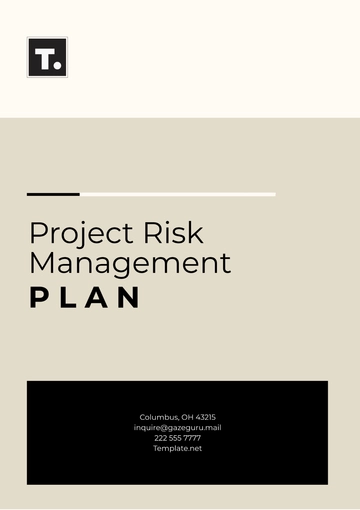Free Climate Change Mitigation Plan

I. Executive Summary
The purpose of this Climate Change Mitigation Plan is to guide [Your Company Name] in reducing its greenhouse gas (GHG) emissions and contributing to global climate stability. Our primary goal is to achieve net-zero emissions by 2060, aligning with international climate agreements and the latest scientific recommendations for limiting global warming. This plan outlines actionable strategies across key sectors including energy, transportation, and waste management to significantly reduce our carbon footprint and contribute to the global effort against climate change.
II. Introduction
A. Background and Context
Climate change remains one of the most urgent challenges facing our world today, with rising global temperatures, sea-level rise, and extreme weather events threatening ecosystems, economies, and human livelihoods. [Your Company Name] recognizes the critical need for proactive mitigation efforts, having already witnessed the effects of climate change on our operations and surrounding communities. Our commitment to addressing this issue reflects the growing global consensus on the need for rapid action to reduce emissions and promote sustainability.
B. Importance of Mitigation Actions
Mitigation strategies focus on reducing the sources of GHG emissions to slow the effects of climate change and limit future environmental damage. The adoption of renewable energy, energy-efficient technologies, and sustainable practices is central to minimizing our carbon footprint. These actions not only contribute to global climate goals but also enhance long-term business resilience and operational efficiency.
C. Purpose and Vision of the Plan
The purpose of this plan is to establish a clear, structured approach to achieving our sustainability goals and meeting the carbon neutrality target by 2060. This plan aligns with international climate goals, including the Paris Agreement's objective to limit global temperature rise to well below 2°C. Our vision is to transform [Your Company Name] into a leader in environmental sustainability, influencing the wider industry to follow suit.
III. Emissions Inventory and Baseline Assessment
A. Identification of Emission Sources
Emission Source | 2030 Emissions (MTCO2e) | 2040 Emissions (MTCO2e) | 2050 Emissions (MTCO2e) |
|---|---|---|---|
Energy Consumption | 350,000 | 200,000 | 100,000 |
Transportation | |||
Industrial Processes | |||
Agriculture and Land Use | |||
Waste Management | |||
Total Emissions |
In 2050, the emissions inventory reveals a substantial reduction in emissions across all sectors, with energy consumption, transportation, and industrial processes being the largest contributors. These reductions are the result of significant investments in renewable energy, carbon-efficient technologies, and optimized transportation systems. Continued monitoring of emission sources will ensure we meet our 2060 net-zero target.
B. Quantification of Greenhouse Gas Emissions
The emissions quantification process was carried out using the IPCC guidelines, focusing on direct and indirect emissions across all business activities. Greenhouse gases have been classified into CO2, CH4, and N2O emissions, calculated based on standard emission factors for each sector. For example, the transition to renewable energy has led to a [00]% decrease in CO2 emissions from electricity usage between 2031 and 2050.
C. Baseline Emissions and Projection
Our baseline emissions, calculated for the year 2031, were 1.15 million metric tons of CO2 equivalent (MTCO2e). This figure has been used as the foundation for projecting future emissions reductions, based on the adoption of cleaner technologies, renewable energy sources, and energy-efficient measures. Our goal is to reduce emissions by at least [00]% by 2050, with ongoing improvements expected through 2060.
IV. Goals and Targets
A. Short-Term Emission Reduction Goals (2031-2040)
During the first phase of this plan, we aim to reduce emissions by [00]% from the baseline by 2040. This will primarily be achieved through the installation of energy-efficient systems across our operations, transitioning to electric vehicle fleets, and investing in renewable energy infrastructure. Key milestones include reducing energy consumption by [00]% and transportation emissions by [00]% within this period.
B. Medium-Term Emission Reduction Goals (2040-2050)
Between 2040 and 2050, we aim for an additional [00]% reduction in emissions, achieving a total reduction of [00]% by 2050. This period will focus on further advancements in carbon capture and storage (CCS) technology and integrating advanced industrial emissions-reduction techniques. By 2050, we also plan to have fully phased out fossil fuels from our energy grid and transitioned all vehicles to zero-emission models.
C. Long-Term Emission Reduction Goals (2050-2060)
The ultimate goal is to achieve net-zero emissions by 2060. To reach this target, we will implement a mix of carbon removal strategies, including large-scale reforestation projects, and further improvements in carbon capture technologies. Our ongoing commitment to sustainability and climate change mitigation will guide our actions toward achieving these ambitious, long-term goals.
V. Mitigation Strategies
A. Renewable Energy Transition
By 2050, [Your Company Name] has transitioned [00]% of its energy consumption to renewable sources, including solar, wind, and hydroelectric power. To meet future energy needs, we are investing in next-generation energy storage solutions to ensure a reliable energy supply. Our goal is to achieve [00]% renewable energy usage by 2060.
B. Energy Efficiency Improvements
We have implemented energy-efficient technologies across our buildings and operations, including LED lighting, high-efficiency HVAC systems, and smart energy management systems. In 2050, these upgrades have resulted in a [00]% reduction in energy consumption compared to 2031 levels. Continued investment in energy-efficient practices will further reduce our operational costs and carbon footprint.
C. Carbon Capture and Storage (CCS)
We have adopted CCS technology in key industrial operations, capturing CO2 from cement production and other manufacturing processes. This has led to a reduction of 100,000 MTCO2e per year in industrial emissions. Our ongoing efforts include scaling up CCS systems across all sectors by 2060.
D. Sustainable Land-Use and Forest Management
Our land-use initiatives focus on reforesting 50,000 acres by 2060, contributing to carbon sequestration and biodiversity preservation. By 2050, our ongoing projects have resulted in the planting of 20,000 acres of trees, capturing over 50,000 MTCO2e annually. These efforts will continue to grow as part of our long-term sustainability strategy.
E. Waste Reduction and Circular Economy
We have implemented circular economy practices by recycling [00]% of our waste and reducing landfill contributions by [00]%. In 2050, waste-to-energy systems are processing [00]% of our organic waste, providing renewable energy for our operations. Our goal is to achieve zero waste to landfill by 2060, further reducing emissions from waste management.
VI. Implementation Framework
A. Key Stakeholders and Responsibilities
The successful implementation of this plan will involve cooperation between various stakeholders, including [Second Party Company Name] for renewable energy supply, local government bodies for regulatory support, and our internal sustainability team for day-to-day management. Clear responsibilities have been outlined for each stakeholder, ensuring accountability at all levels.
B. Action Plan and Timeline
The timeline for implementation spans from 2031 to 2060, with specific actions outlined for each five-year period. For instance, by 2040, our target is to achieve a [00]% reduction in emissions, and by 2050, we aim for a [00]% reduction. Detailed action plans, with specific projects and deadlines, are included in the full report.
C. Resource Allocation and Budget
Our estimated budget for the implementation of this Climate Change Mitigation Plan is $[00] million over the next 10 years, with funding primarily allocated to renewable energy projects, energy efficiency retrofits, and CCS technologies. Financial models show a positive return on investment through energy savings and carbon credit revenue.
VII. Risk Management and Adaptation Considerations
A. Identifying Risks to Mitigation Actions
One of the key risks to our mitigation efforts includes the potential for technological failures or slow adoption of new clean technologies. For instance, reliance on advanced carbon capture and storage (CCS) systems and renewable energy infrastructure could be hindered by technical challenges or supply chain disruptions. Political factors, such as changes in climate policies or lack of government incentives, could also delay the implementation of certain projects.
B. Adaptation Measures to Address Risks
To mitigate these risks, we have developed a contingency plan that includes diversifying our energy sources and carbon reduction technologies. We are also investing in research and development (R&D) to stay ahead of technological advancements, ensuring that we can adopt the latest and most effective solutions. Furthermore, we will maintain regular dialogues with policymakers and stakeholders to stay informed of regulatory changes and adapt our strategies accordingly.
C. Contingency Plans and Flexibility in Strategy
Our mitigation plan is designed with flexibility in mind, allowing for periodic reassessment and adaptation to new circumstances. For example, if unforeseen technological barriers arise, we will prioritize alternative solutions such as additional renewable energy investments or increased emphasis on carbon sequestration. By monitoring both internal and external factors, we can adjust our plan in real time, ensuring we stay on track to meet our 2060 net-zero target.
VIII. Stakeholder Engagement and Public Participation
A. Stakeholder Mapping
Key stakeholders in the successful execution of this Climate Change Mitigation Plan include internal teams (e.g., sustainability, operations, and finance departments), external partners like [Second Party Company Name], local governments, NGOs, and the wider community. Our approach to engagement involves identifying stakeholder interests, assessing their influence on the project, and ensuring that all relevant voices are heard throughout the process.
B. Public Awareness Campaigns
We will launch public awareness campaigns to educate both employees and the local community about the importance of climate action and the steps they can take to reduce their personal carbon footprints. These campaigns will utilize digital platforms, local events, and media partnerships to reach a broad audience. In 2050, we aim to have reached over 1 million individuals through these outreach initiatives, with the goal of increasing community-wide engagement in sustainable practices.
C. Partnerships and Collaboration Opportunities
We are committed to fostering partnerships with research institutions, technology providers, and other businesses to share knowledge, improve mitigation efforts, and achieve shared sustainability goals. Collaborative initiatives such as green financing and joint renewable energy projects with [Second Party Company Name] will accelerate the transition to a low-carbon economy. We will also collaborate with global climate organizations to stay at the forefront of the latest strategies and best practices.
IX. Monitoring, Reporting, and Continuous Improvement
A. Monitoring and Data Collection
A key component of this plan is the robust monitoring system we have in place to track emissions reductions, energy usage, and progress against established targets. We use an integrated software platform to collect real-time data from all operational sites and assess the impact of specific mitigation measures. This allows us to identify areas for improvement and ensure alignment with our overall emission reduction goals.
B. Reporting Mechanisms
We will continue to report our progress annually through comprehensive sustainability reports, which will be available to stakeholders and the general public. These reports will include detailed emissions data, updates on our mitigation strategies, and an assessment of any adjustments made to the plan. In addition, we will submit progress reports to international climate bodies, including the United Nations Framework Convention on Climate Change (UNFCCC), to ensure transparency and accountability.
C. Continuous Improvement Process
The Climate Change Mitigation Plan is a living document, designed to evolve as new technologies, strategies, and scientific findings emerge. We will review our progress every five years, adjusting our targets and strategies to account for new opportunities and challenges. A feedback loop will be established, incorporating lessons learned from both successes and setbacks, to ensure continuous improvement and long-term success.
X. Conclusion
A. Summary of Key Findings and Goals
The Climate Change Mitigation Plan for [Your Company Name] outlines a clear, actionable path to achieving net-zero emissions by 2060, with a [00]% reduction by 2050. This comprehensive plan focuses on key mitigation strategies, including renewable energy transition, energy efficiency, carbon capture, and sustainable land-use management. The outlined goals and strategies represent our commitment to reducing our environmental impact and meeting global climate objectives.
B. Importance of Collective Effort and Long-Term Commitment
Addressing climate change is not a challenge we can overcome alone. This plan requires collaboration with governments, businesses, and communities to achieve the scale of change needed. It also demands a long-term commitment to sustainability, innovation, and accountability from all stakeholders.
C. Call to Action for Stakeholders
We call on all stakeholders, including employees, business partners like [Second Party Company Name], and local communities, to actively engage with and support the implementation of this plan. Together, we can ensure a more sustainable and resilient future for generations to come.
D. Next Steps in the Implementation Process
The immediate next step in implementing this plan will be to conduct an in-depth review of our current operations, focusing on identifying areas where emissions can be reduced quickly. We will also begin the process of setting up a project management team to oversee the rollout of renewable energy projects, waste management improvements, and carbon capture technologies. In 2031, we will hold our first major stakeholder meeting to align all parties on the upcoming actions and timelines.
- 100% Customizable, free editor
- Access 1 Million+ Templates, photo’s & graphics
- Download or share as a template
- Click and replace photos, graphics, text, backgrounds
- Resize, crop, AI write & more
- Access advanced editor
Utilize the Climate Change Mitigation Plan Template from Template.net to create a comprehensive, professional plan for your business’s sustainability goals. Fully editable and customizable, this template allows you to tailor every detail to your specific needs. With the powerful AI Editor Tool, easily refine and update your plan, ensuring it aligns with your climate goals.
You may also like
- Finance Plan
- Construction Plan
- Sales Plan
- Development Plan
- Career Plan
- Budget Plan
- HR Plan
- Education Plan
- Transition Plan
- Work Plan
- Training Plan
- Communication Plan
- Operation Plan
- Health And Safety Plan
- Strategy Plan
- Professional Development Plan
- Advertising Plan
- Risk Management Plan
- Restaurant Plan
- School Plan
- Nursing Home Patient Care Plan
- Nursing Care Plan
- Plan Event
- Startup Plan
- Social Media Plan
- Staffing Plan
- Annual Plan
- Content Plan
- Payment Plan
- Implementation Plan
- Hotel Plan
- Workout Plan
- Accounting Plan
- Campaign Plan
- Essay Plan
- 30 60 90 Day Plan
- Research Plan
- Recruitment Plan
- 90 Day Plan
- Quarterly Plan
- Emergency Plan
- 5 Year Plan
- Gym Plan
- Personal Plan
- IT and Software Plan
- Treatment Plan
- Real Estate Plan
- Law Firm Plan
- Healthcare Plan
- Improvement Plan
- Media Plan
- 5 Year Business Plan
- Learning Plan
- Marketing Campaign Plan
- Travel Agency Plan
- Cleaning Services Plan
- Interior Design Plan
- Performance Plan
- PR Plan
- Birth Plan
- Life Plan
- SEO Plan
- Disaster Recovery Plan
- Continuity Plan
- Launch Plan
- Legal Plan
- Behavior Plan
- Performance Improvement Plan
- Salon Plan
- Security Plan
- Security Management Plan
- Employee Development Plan
- Quality Plan
- Service Improvement Plan
- Growth Plan
- Incident Response Plan
- Basketball Plan
- Emergency Action Plan
- Product Launch Plan
- Spa Plan
- Employee Training Plan
- Data Analysis Plan
- Employee Action Plan
- Territory Plan
- Audit Plan
- Classroom Plan
- Activity Plan
- Parenting Plan
- Care Plan
- Project Execution Plan
- Exercise Plan
- Internship Plan
- Software Development Plan
- Continuous Improvement Plan
- Leave Plan
- 90 Day Sales Plan
- Advertising Agency Plan
- Employee Transition Plan
- Smart Action Plan
- Workplace Safety Plan
- Behavior Change Plan
- Contingency Plan
- Continuity of Operations Plan
- Health Plan
- Quality Control Plan
- Self Plan
- Sports Development Plan
- Change Management Plan
- Ecommerce Plan
- Personal Financial Plan
- Process Improvement Plan
- 30-60-90 Day Sales Plan
- Crisis Management Plan
- Engagement Plan
- Execution Plan
- Pandemic Plan
- Quality Assurance Plan
- Service Continuity Plan
- Agile Project Plan
- Fundraising Plan
- Job Transition Plan
- Asset Maintenance Plan
- Maintenance Plan
- Software Test Plan
- Staff Training and Development Plan
- 3 Year Plan
- Brand Activation Plan
- Release Plan
- Resource Plan
- Risk Mitigation Plan
- Teacher Plan
- 30 60 90 Day Plan for New Manager
- Food Safety Plan
- Food Truck Plan
- Hiring Plan
- Quality Management Plan
- Wellness Plan
- Behavior Intervention Plan
- Bonus Plan
- Investment Plan
- Maternity Leave Plan
- Pandemic Response Plan
- Succession Planning
- Coaching Plan
- Configuration Management Plan
- Remote Work Plan
- Self Care Plan
- Teaching Plan
- 100-Day Plan
- HACCP Plan
- Student Plan
- Sustainability Plan
- 30 60 90 Day Plan for Interview
- Access Plan
- Site Specific Safety Plan





























